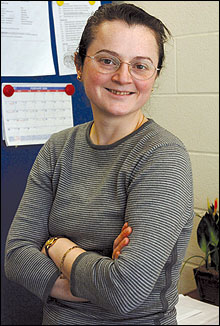Archives
Physicist’s focus is experimental
Ia Iashvili’s work in high-energy physics specializes in experiments, rather than theory
By JESSICA KELTZ
Reporter Contributor
As UB's first high-energy physicists who specialize in experiments, as opposed to theory, Ia Iashvili says she and her husband love the freedom of building a program from scratch while continuing to collaborate with academics all over the world.

Ia Iashvili and her husband,
Avtandyl Kharchilava, are UB’s first high-energy physicists who
specialize in experiments, as opposed to theory.
PHOTO: NANCY J.
PARISI
"We can do whatever we choose to do," says Iashvili, who joined the faculty of the Department of Physics last fall as an assistant professor. "The direction of our research we can choose ourselves."
Iashvili came to UB with her husband, Avtandyl Kharchilava, also a UB assistant professor of physics, after a five-year postdoctoral appointment at the University of California-Riverside that placed her at Fermi National Accelerator Laboratory (Fermilab) in Batavia, Ill., just outside Chicago. She and Kharchilava continue to be part of the research collaboration there, making UB an official partner in a project called The DØ (pronounced "d-zero") Experiment.
The DØ Experiment is working with the Tevatron Collider, the world's premier high-energy accelerator, located at Fermilab. The collider, which accelerates protons and antiprotons into head-on collisions, has a radius of one kilometer, or about six-tenths of a mile. Researchers cannot see these particles, of course, as they are smaller than atoms, so the accelerator features detectors that determine what happens during the collisions and what types of particles are generated. The particular detector here is called DØ and from that the collaboration takes its name, Iashvili explains.
She says the goal of these experiments is to better understand energy and fundamental particles—particles that make up atoms that in turn make up cells.
Researchers probe the limits of the "standard theory," which explains fundamental particles and states that they should have no mass. So far, she says, physicists have shown that photons (the particles that make up light) in fact do not have mass as the theory postulates. But it seems impossible that the particles that make up atoms—and, hence, everything else—would not have mass.
The difference, Iashvili says, appears to be a particle researchers call Higgs, which interacts with fundamental particles in a way that gives them mass.
"The entire picture rests on this assumption," she says.
The only problem is that researchers have found no physical evidence that Higgs exists. They have found, however, that the standard theory, which has been rigorously tested for the past 30 years, explains the outcomes of experiments within one-tenth of a percent precision. Iashvili says the standard theory provides a range for what Higgs' mass should be, but not an exact mass.
That's where particle accelerators come in. Researchers hope that one of their proton/anti-proton collisions will produce a Higgs particle. The heavier Higgs is, the more energy would be needed to produce it in one of these reactions, Iashvili says. And there's a chance that, depending on how heavy Higgs is, that its discovery may not happen until a faster particle accelerator comes along—which is slated to happen in Switzerland in 2007.
Iashvili says that even with the capacity to produce Higgs in a reaction, researchers still would have to stage many collisions to produce it.
"Higgs is not the only particle that will be produced," she says, explaining that a host of results—both particles and the release of energy—come from each collision.
She notes that Higgs is not the only undiscovered particle researchers hope to find—just the one she thinks is especially important. In addition to finding new particles, researchers hope to study further the properties of previously discovered particles, she adds.
Iashvili grew up in the former Soviet republic of Georgia, where she earned a master's degree in physics from Tbilisi State University. She worked as a researcher there until 1995, when she moved to Strasbourg, France, for another research position, and then to Berlin, where she earned her doctorate from Humboldt University in 2000.
Although Iashvili says there was much wrong with Georgia's old Soviet-style ways of doing things, she says she did receive a strong primary and secondary education there.
"Solid and rigorous training was a key to the former Soviet educational system. After you are trained you become fluent and it doesn't scare you anymore," she says of the study of science and math, two topics she knows intimidate many American students.
"People think it's somehow mysterious," she says. "It is hard for me to understand because my parents were very good at physics and math, and my brother is a mathematician."
Although Iashvili thinks the way science and math is taught in the United States needs to be rethought, she says the American system lends itself to a fuller college-level experience, where it's easier to be an independent thinker than it was in Georgia.
"I hope that the discipline will be kept and the positive things about the Western system will be adopted," she said of her home country.
Iashvili and Kharchilava live in Getzville with their two-and-a-half-year-old son. She says that since the birth of her son, their lives have become "more balanced" and they have a world outside of work. In general, the move to the Buffalo area and to UB has been a good one, she says.
"We really like the department here because people are so friendly," she says. "They really want you to succeed, so that was very positive when we moved here."
